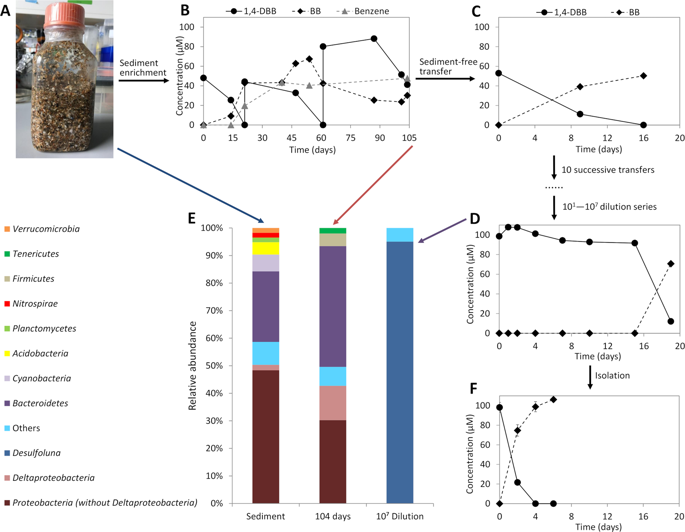Our official English website, www.x-mol.net, welcomes your
feedback! (Note: you will need to create a separate account there.)
Organohalide-respiring Desulfoluna species isolated from marine environments.
The ISME Journal ( IF 10.8 ) Pub Date : 2020-01-02 , DOI: 10.1038/s41396-019-0573-y Peng Peng 1 , Tobias Goris 2, 3 , Yue Lu 4 , Bart Nijsse 5 , Anna Burrichter 6, 7 , David Schleheck 6, 7 , Jasper J Koehorst 5 , Jie Liu 8 , Detmer Sipkema 1 , Jaap S Sinninghe Damste 9, 10 , Alfons J M Stams 1, 11 , Max M Häggblom 8 , Hauke Smidt 1 , Siavash Atashgahi 1
The ISME Journal ( IF 10.8 ) Pub Date : 2020-01-02 , DOI: 10.1038/s41396-019-0573-y Peng Peng 1 , Tobias Goris 2, 3 , Yue Lu 4 , Bart Nijsse 5 , Anna Burrichter 6, 7 , David Schleheck 6, 7 , Jasper J Koehorst 5 , Jie Liu 8 , Detmer Sipkema 1 , Jaap S Sinninghe Damste 9, 10 , Alfons J M Stams 1, 11 , Max M Häggblom 8 , Hauke Smidt 1 , Siavash Atashgahi 1
Affiliation

|
The genus Desulfoluna comprises two anaerobic sulfate-reducing strains, D. spongiiphila AA1T and D. butyratoxydans MSL71T, of which only the former was shown to perform organohalide respiration (OHR). Here we isolated a third strain, designated D. spongiiphila strain DBB, from marine intertidal sediment using 1,4-dibromobenzene and sulfate as the electron acceptors and lactate as the electron donor. Each strain harbors three reductive dehalogenase gene clusters (rdhABC) and corrinoid biosynthesis genes in their genomes, and dehalogenated brominated but not chlorinated organohalogens. The Desulfoluna strains maintained OHR in the presence of 20 mM sulfate or 20 mM sulfide, which often negatively affect other organohalide-respiring bacteria. Strain DBB sustained OHR with 2% oxygen in the gas phase, in line with its genetic potential for reactive oxygen species detoxification. Reverse transcription-quantitative PCR revealed differential induction of rdhA genes in strain DBB in response to 1,4-dibromobenzene or 2,6-dibromophenol. Proteomic analysis confirmed expression of rdhA1 with 1,4-dibromobenzene, and revealed a partially shared electron transport chain from lactate to 1,4-dibromobenzene and sulfate, which may explain accelerated OHR during concurrent sulfate reduction. Versatility in using electron donors, de novo corrinoid biosynthesis, resistance to sulfate, sulfide and oxygen, and concurrent sulfate reduction and OHR may confer an advantage to marine Desulfoluna strains.
中文翻译:

从海洋环境中分离出的可呼吸有机卤化物的 Desulfoluna 物种。
Desulfoluna 属包括两种厌氧硫酸盐还原菌株,D. spongiiphila AA1T 和 D. butyratoxydans MSL71T,其中只有前者显示出进行有机卤化物呼吸 (OHR)。在这里,我们使用 1,4-二溴苯和硫酸盐作为电子受体,乳酸作为电子供体,从海洋潮间带沉积物中分离出第三种菌株,称为 D. spongiiphila 菌株 DBB。每个菌株的基因组中都含有三个还原性脱卤酶基因簇 (rdhABC) 和类咕啉生物合成基因,以及脱卤溴化但不含有氯化有机卤素。Desulfoluna 菌株在 20 mM 硫酸盐或 20 mM 硫化物存在下维持 OHR,这通常会对其他有机卤化物呼吸细菌产生负面影响。菌株 DBB 在气相中以 2% 的氧气维持 OHR,符合其活性氧解毒的遗传潜力。逆转录定量 PCR 揭示了菌株 DBB 中 rdhA 基因对 1,4-二溴苯或 2,6-二溴苯酚的反应差异诱导。蛋白质组学分析证实了 rdhA1 与 1,4-二溴苯的表达,并揭示了从乳酸到 1,4-二溴苯和硫酸盐的部分共享电子传递链,这可以解释同时硫酸盐还原过程中加速 OHR。使用电子供体的多功能性、从头类可啉生物合成、对硫酸盐、硫化物和氧气的抗性以及同时发生的硫酸盐还原和 OHR 可能赋予海洋 Desulfoluna 菌株优势。6-二溴苯酚。蛋白质组学分析证实了 rdhA1 与 1,4-二溴苯的表达,并揭示了从乳酸到 1,4-二溴苯和硫酸盐的部分共享电子传递链,这可以解释同时硫酸盐还原过程中加速 OHR。使用电子供体的多功能性、从头类可啉生物合成、对硫酸盐、硫化物和氧气的抗性以及同时发生的硫酸盐还原和 OHR 可能赋予海洋 Desulfoluna 菌株优势。6-二溴苯酚。蛋白质组学分析证实了 rdhA1 与 1,4-二溴苯的表达,并揭示了从乳酸到 1,4-二溴苯和硫酸盐的部分共享电子传递链,这可以解释同时硫酸盐还原过程中加速 OHR。使用电子供体的多功能性、从头类可啉生物合成、对硫酸盐、硫化物和氧气的抗性以及同时发生的硫酸盐还原和 OHR 可能赋予海洋 Desulfoluna 菌株优势。
更新日期:2020-01-17
中文翻译:

从海洋环境中分离出的可呼吸有机卤化物的 Desulfoluna 物种。
Desulfoluna 属包括两种厌氧硫酸盐还原菌株,D. spongiiphila AA1T 和 D. butyratoxydans MSL71T,其中只有前者显示出进行有机卤化物呼吸 (OHR)。在这里,我们使用 1,4-二溴苯和硫酸盐作为电子受体,乳酸作为电子供体,从海洋潮间带沉积物中分离出第三种菌株,称为 D. spongiiphila 菌株 DBB。每个菌株的基因组中都含有三个还原性脱卤酶基因簇 (rdhABC) 和类咕啉生物合成基因,以及脱卤溴化但不含有氯化有机卤素。Desulfoluna 菌株在 20 mM 硫酸盐或 20 mM 硫化物存在下维持 OHR,这通常会对其他有机卤化物呼吸细菌产生负面影响。菌株 DBB 在气相中以 2% 的氧气维持 OHR,符合其活性氧解毒的遗传潜力。逆转录定量 PCR 揭示了菌株 DBB 中 rdhA 基因对 1,4-二溴苯或 2,6-二溴苯酚的反应差异诱导。蛋白质组学分析证实了 rdhA1 与 1,4-二溴苯的表达,并揭示了从乳酸到 1,4-二溴苯和硫酸盐的部分共享电子传递链,这可以解释同时硫酸盐还原过程中加速 OHR。使用电子供体的多功能性、从头类可啉生物合成、对硫酸盐、硫化物和氧气的抗性以及同时发生的硫酸盐还原和 OHR 可能赋予海洋 Desulfoluna 菌株优势。6-二溴苯酚。蛋白质组学分析证实了 rdhA1 与 1,4-二溴苯的表达,并揭示了从乳酸到 1,4-二溴苯和硫酸盐的部分共享电子传递链,这可以解释同时硫酸盐还原过程中加速 OHR。使用电子供体的多功能性、从头类可啉生物合成、对硫酸盐、硫化物和氧气的抗性以及同时发生的硫酸盐还原和 OHR 可能赋予海洋 Desulfoluna 菌株优势。6-二溴苯酚。蛋白质组学分析证实了 rdhA1 与 1,4-二溴苯的表达,并揭示了从乳酸到 1,4-二溴苯和硫酸盐的部分共享电子传递链,这可以解释同时硫酸盐还原过程中加速 OHR。使用电子供体的多功能性、从头类可啉生物合成、对硫酸盐、硫化物和氧气的抗性以及同时发生的硫酸盐还原和 OHR 可能赋予海洋 Desulfoluna 菌株优势。











































 京公网安备 11010802027423号
京公网安备 11010802027423号